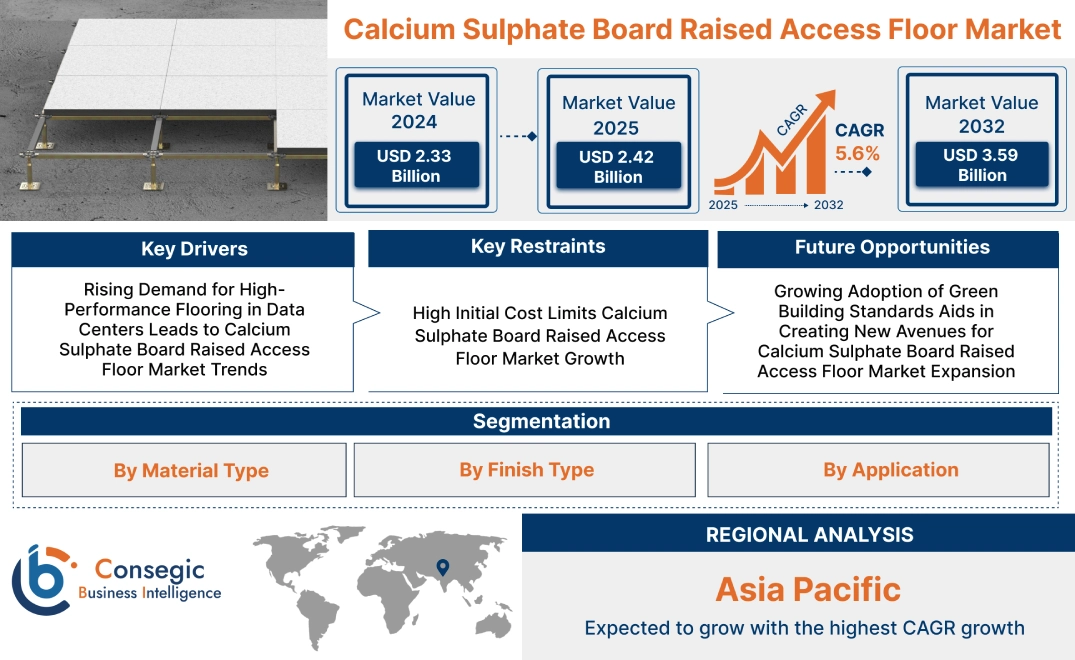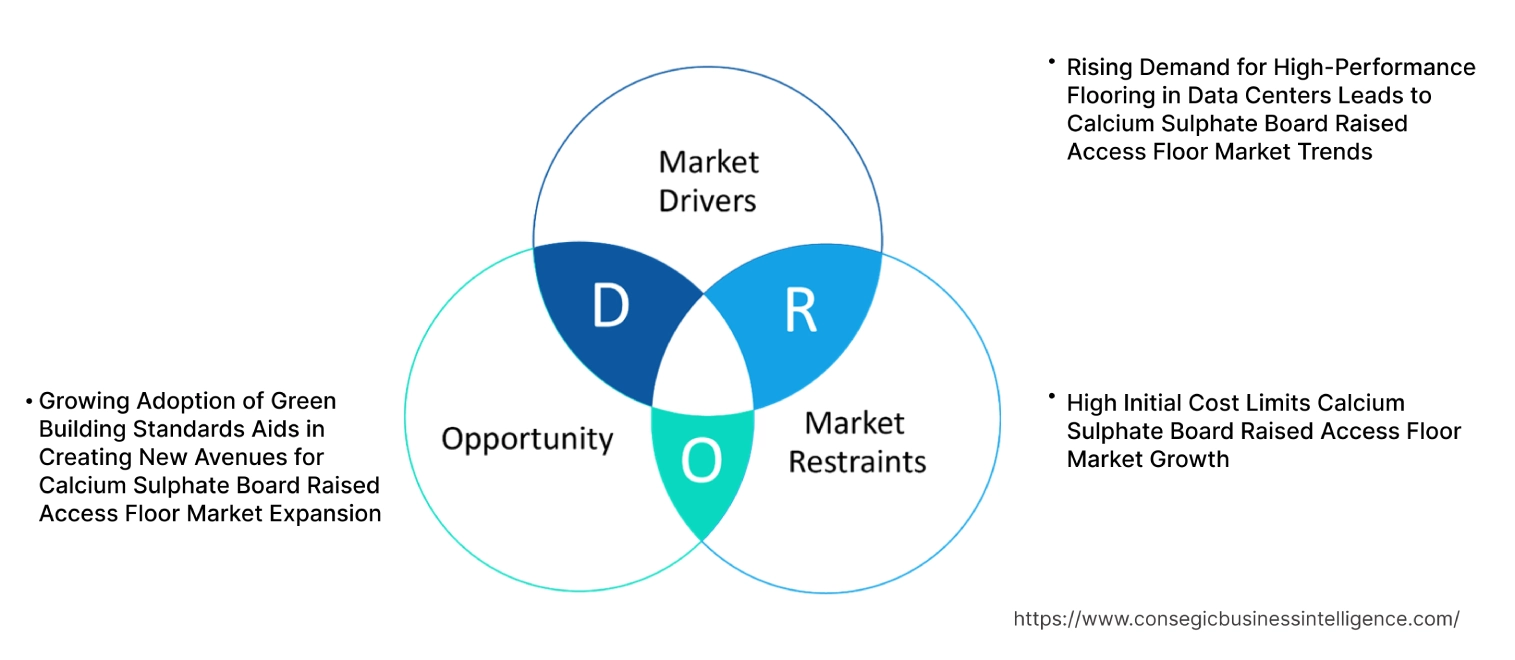- Summary
- Table Of Content
- Methodology
Calcium Sulphate Board Raised Access Floor Market Size:
Calcium Sulphate Board Raised Access Floor Market size is estimated to reach over USD 3.59 Billion by 2032 from a value of USD 2.33 Billion in 2024 and is projected to grow by USD 2.42 Billion in 2025, growing at a CAGR of 5.6% from 2025 to 2032.
Calcium Sulphate Board Raised Access Floor Market Scope & Overview:
Calcium sulphate board raised access floors are modular flooring systems designed to create an elevated surface for efficient space management. These floors consist of high-density calcium sulphate core panels that offer strength, stability, and fire resistance. They provide a durable and load-bearing solution for commercial and industrial environments.
Key features include moisture resistance, acoustic insulation, and anti-static properties. These floors enhance structural integrity, support heavy equipment, and reduce noise transmission. They allow easy access to electrical wiring, HVAC systems, and data cables, ensuring organized space utilization.
These flooring systems are widely used in data centers, offices, healthcare facilities, and manufacturing plants. They support infrastructure in telecommunications, financial institutions, and control rooms where efficient cable management is essential.
Key Drivers:
Rising Demand for High-Performance Flooring in Data Centers Leads to Calcium Sulphate Board Raised Access Floor Market Trends
Data centers require high-performance flooring solutions that support heavy equipment while offering effective cable management. Calcium sulphate board raised access floors provide superior load-bearing capacity, fire resistance, and sound insulation compared to conventional flooring materials. These floors allow for better airflow management, which is critical in maintaining optimal temperature conditions for servers and IT infrastructure. For example, modern data centers increasingly utilize calcium sulphate-based flooring to accommodate high-density server racks while ensuring structural stability and ease of maintenance. Therefore, the growing construction of data centers globally is fueling the trend for calcium sulphate board raised access floors.
Key Restraints:
High Initial Cost Limits Calcium Sulphate Board Raised Access Floor Market Growth
The installation of calcium sulphate board raised access floors involves significant costs related to material procurement, structural reinforcements, and labor expenses. Compared to traditional concrete or wood-based flooring systems, calcium sulphate boards are more expensive due to their enhanced fire resistance, load capacity, and durability. Additionally, businesses operating on tight budgets may opt for cost-effective alternatives, reducing the preference for these floors. For instance, commercial offices and retail spaces often choose more economical raised flooring systems, limiting the widespread adoption of calcium sulphate board raised access floors. These high upfront costs pose a challenge for the calcium sulphate board raised access floor market expansion, especially in price-sensitive regions.
Future Opportunities :
Growing Adoption of Green Building Standards Aids in Creating New Avenues for Calcium Sulphate Board Raised Access Floor Market Expansion
Future construction projects are expected to emphasize sustainability and eco-friendly materials due to stringent environmental regulations and corporate sustainability initiatives. Calcium sulphate board raised access floors align with green building certifications such as LEED (Leadership in Energy and Environmental Design) due to their recyclability and low environmental impact. As companies and governments focus on reducing carbon footprints, the growth for sustainable building materials is projected to increase. For example, the rising trend of eco-friendly commercial spaces and smart offices will drive the preference for calcium sulphate-based flooring solutions. Therefore, the shift toward green construction practices presents significant growth opportunities for the calcium sulphate board raised access floor market.
Calcium Sulphate Board Raised Access Floor Market Segmental Analysis :
By Material Type:
Based on material type, the market is segmented into calcium sulphate board core, steel encapsulated core, and aluminum encapsulated core.
The calcium sulphate board core segment accounted for the largest revenue share in calcium sulphate board raised access floor market by 46.7% in 2024.
- It is widely utilized due to its high load-bearing capacity, fire resistance, and eco-friendly nature.
- This material offers excellent acoustic insulation and stability, making it suitable for commercial and industrial applications.
- According to market analysis, calcium sulphate board raised access floor market opportunities is attributed to increasing trend in data centers and office spaces where durability and safety are crucial.
- Additionally, the material is resistant to humidity and temperature variations, enhancing its longevity in various settings.
The steel encapsulated core segment is anticipated to register the fastest CAGR during the forecast period.
- It provides superior strength and durability, making it ideal for high-traffic areas and heavy-load applications.
- Steel encapsulated panels offer enhanced fire resistance and protection against mechanical damage.
- Growing investments in modern infrastructure, particularly in data centers and industrial spaces, contribute to the rising adoption of steel encapsulated core raised access flooring systems.
- According to calcium sulphate board raised access floor market analysis, the segment's growth is further supported by stringent safety regulations requiring robust flooring solutions in commercial buildings.
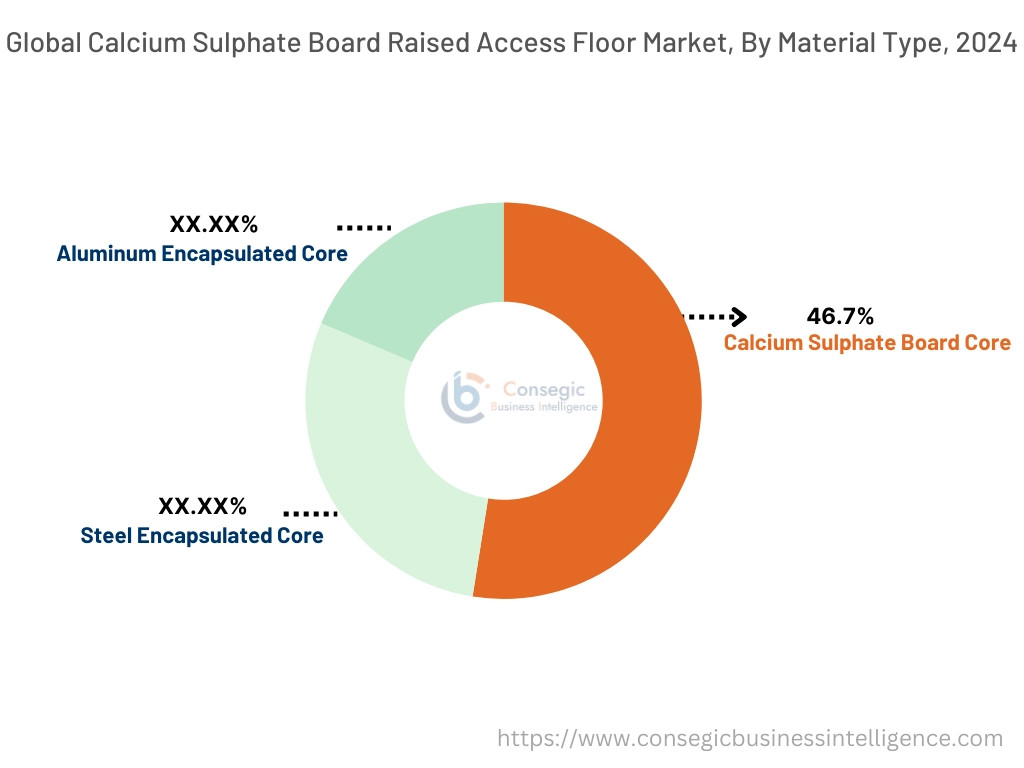
By Finish Type:
Based on finish type, the market is segmented into laminate finish, PVC finish, ceramic finish, wood finish, and others.
The laminate finish segment accounted for the largest revenue in calcium sulphate board raised access floor market share in 2024.
- It is preferred for its durability, ease of maintenance, and aesthetic appeal.
- Laminate finish panels are widely used in office spaces and data centers due to their resistance to scratches, stains, and moisture.
- The availability of multiple design options and cost-effectiveness contribute to the segment's market dominance.
- According to market analysis, increasing preference for customizable and decorative flooring solutions in corporate environments further strengthens the demand.
The ceramic finish segment is anticipated to register the fastest CAGR during the forecast period.
- It offers high wear resistance, easy maintenance, and an elegant appearance, making it suitable for premium office spaces and retail environments.
- Ceramic finish panels are also highly resistant to moisture, making them a preferred choice for healthcare and educational institutions.
- According to calcium sulphate board raised access floor market analysis, the segment's rapid expansion is driven by increasing investments in luxury commercial infrastructure and the rising preference for sophisticated interior designs.
By Application:
Based on application, the market is segmented into data centers, offices, retail spaces, healthcare facilities, educational institutions, and industrial spaces.
The data centers segment accounted for the largest revenue share in 2024.
- Raised access floors in data centers allow for efficient cable management and optimal airflow distribution, ensuring proper cooling of IT equipment.
- The increasing deployment of large-scale data centers worldwide, driven by cloud computing and artificial intelligence, is contributing to segment growth.
- The high load-bearing capacity and fire resistance of calcium sulphate board raised floors make them ideal for data centers.
- According to market analysis, stringent regulatory requirements for data center infrastructure further support the trend for these flooring solutions.
The healthcare facilities segment is anticipated to register the fastest CAGR during the forecast period.
- Hospitals and medical centers are adopting raised access flooring for improved sanitation, ease of maintenance, and flexible infrastructure design.
- These floors facilitate efficient installation of medical equipment and utility systems while minimizing disruptions during maintenance.
- According to market analysis, the calcium sulphate board raised access floor market opportunities is driven by increasing investments in healthcare infrastructure and the growing emphasis on infection control through hygienic flooring solutions.
Regional Analysis:
The regions covered are North America, Europe, Asia Pacific, the Middle East and Africa, and Latin America.
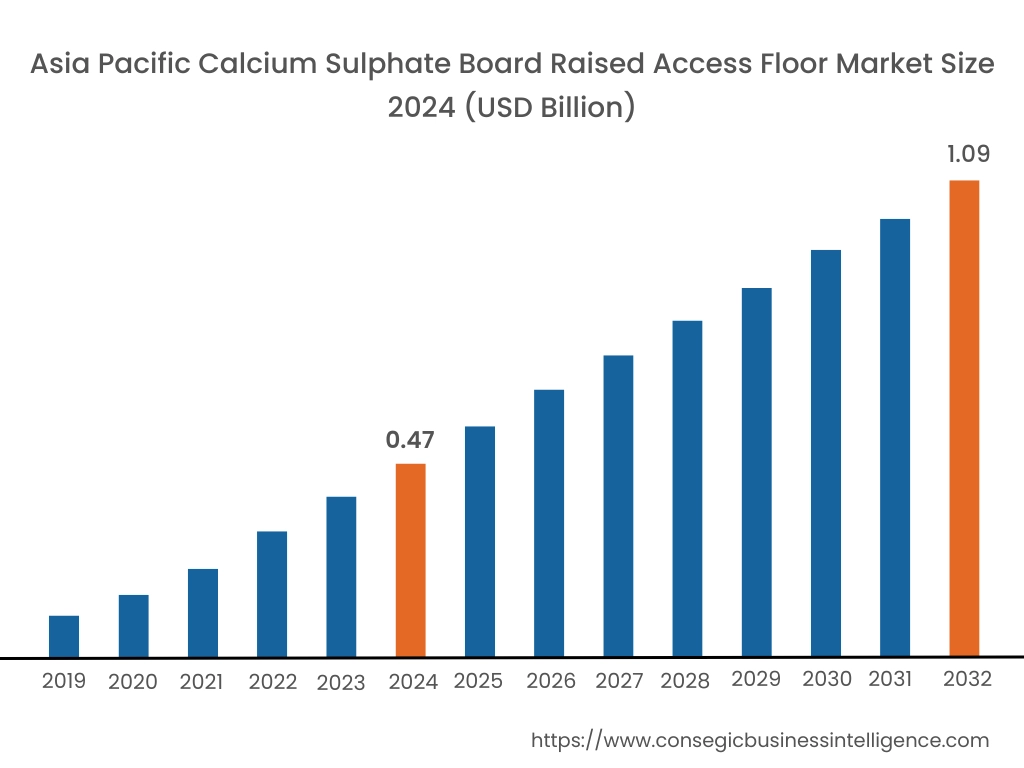
Asia Pacific region was valued at USD 0.47 Billion in 2024. Moreover, it is projected to grow by USD 0.51 Billion in 2025 and reach over USD 1.09 Billion by 2032. Out of this, China accounted for the maximum revenue share of 33.2%. Asia-Pacific is witnessing rising requirement for calcium sulphate board raised access floors, driven by rapid urbanization and the expansion of the IT and telecom sectors. Countries like China, Japan, and India invest in smart buildings and high-tech office spaces, increasing market trend. Government initiatives promoting sustainable construction practices and energy-efficient infrastructure influence market dynamics. The presence of domestic manufacturers contributes to competitive pricing.
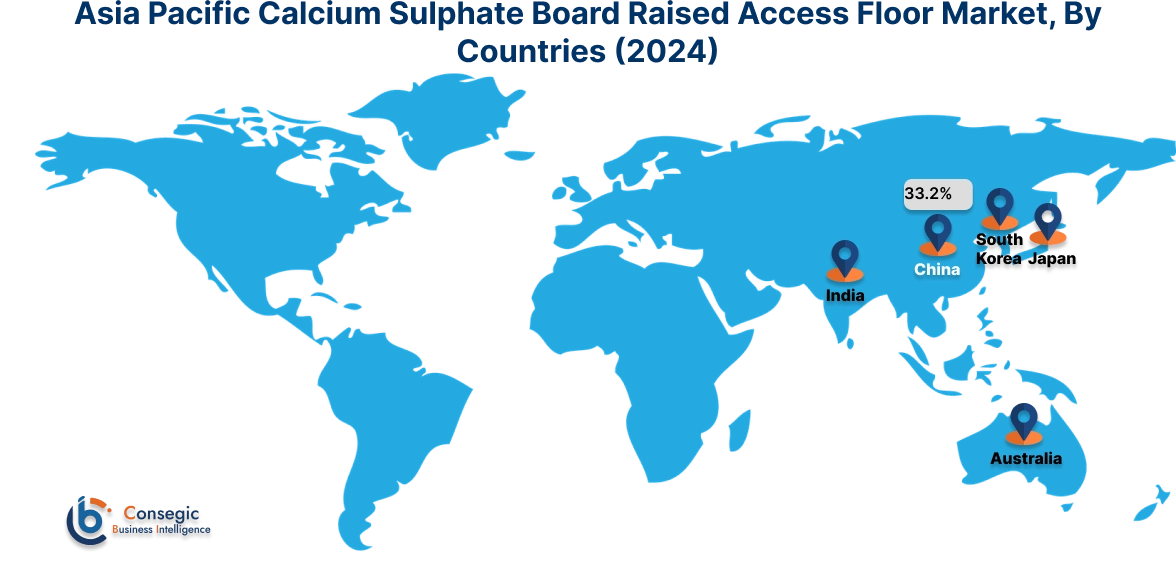
In 2024, North America was valued at USD 0.86 Billion and is expected to reach USD 1.16 Billion in 2032. North America holds a significant share in the calcium sulphate board raised access floor market due to high demand from data centers, corporate offices, and commercial buildings. The United States leads the market with increasing adoption in IT infrastructure and green building projects. Stringent building regulations and fire safety standards influence calcium sulphate board raised access floor market demand. The presence of key manufacturers and strong distribution networks supports market expansion.
Europe maintains steady ask for calcium sulphate board raised access floors, supported by stringent environmental regulations and sustainable building practices. Countries like Germany, the United Kingdom, and France prioritize the use of recyclable and fire-resistant materials in commercial buildings. Growing adoption in financial institutions, data centers, and co-working spaces impacts calcium sulphate board raised access floor market trends. Research and development in innovative flooring solutions contribute to product advancements.
he Middle East and Africa are experiencing increasing adoption of calcium sulphate board raised access floors due to rising investments in commercial real estate and infrastructure development. Countries like the UAE and Saudi Arabia focus on high-end office spaces and smart buildings, influencing market trends. Demand from financial institutions and high-rise commercial buildings supports market expansion. In Africa, infrastructure constraints impact widespread adoption.
Latin America has a developing market, driven by commercial construction projects in countries like Brazil and Mexico. Increasing investments in office spaces, financial institutions, and IT infrastructure contribute to calcium sulphate board raised access floor market demand. Economic fluctuations and varying construction regulations affect calcium sulphate board raised access floor market growth. Rising awareness of fire-resistant and eco-friendly building materials influences market adoption.
Top Key Players and Market Share Insights:
The Global Calcium Sulphate Board Raised Access Floor Market is highly competitive with major players providing products and services to the national and international markets. Key players are adopting several strategies in research and development (R&D), product innovation, and end-user launches to hold a strong position in the Global Calcium Sulphate Board Raised Access Floor Market. Key players in the Calcium Sulphate Board Raised Access Floor industry include-
- Kingspan Group (Ireland)
- Haworth Inc. (United States)
- Lenzlinger Access Floors (Switzerland)
- MERO-TSK International GmbH & Co. KG (Germany)
- PORCELANOSA Group (Spain)
- JVP Floor Solutions (United Kingdom)
- Changzhou Huatong Xinli Flooring Co., Ltd. (China)
- UNITILE Raised Floors (Russia)
- Polygroup (Spain)
- Huiya Raised Floor Co., Ltd. (China)
Calcium Sulphate Board Raised Access Floor Market Report Insights :
| Report Attributes | Report Details |
| Study Timeline | 2019-2032 |
| Market Size in 2032 | USD 3.59 Billion |
| CAGR (2025-2032) | 5.6% |
| By Material Type |
|
| By Finish Type |
|
| By Application |
|
| By Region |
|
| Key Players |
|
| North America | U.S. Canada Mexico |
| Europe | U.K. Germany France Spain Italy Russia Benelux Rest of Europe |
| APAC | China South Korea Japan India Australia ASEAN Rest of Asia-Pacific |
| Middle East and Africa | GCC Turkey South Africa Rest of MEA |
| LATAM | Brazil Argentina Chile Rest of LATAM |
| Report Coverage |
|
Key Questions Answered in the Report
How big is the Calcium Sulphate Board Raised Access Floor Market? +
In 2024, the Calcium Sulphate Board Raised Access Floor Market was USD 2.33 Billion.
What will be the potential market valuation for the Calcium Sulphate Board Raised Access Floor Market by 2032? +
In 2032, the market size of Calcium Sulphate Board Raised Access Floor Market is expected to reach USD 3.59 Billion.
What are the segments covered in the Calcium Sulphate Board Raised Access Floor Market report? +
The material type, finish type and application are the segments covered in this report.
Who are the major players in the Calcium Sulphate Board Raised Access Floor Market? +
Kingspan Group (Ireland), Haworth Inc. (United States), Lenzlinger Access Floors (Switzerland), MERO-TSK International GmbH & Co. KG (Germany), PORCELANOSA Group (Spain), JVP Floor Solutions (United Kingdom), Changzhou Huatong Xinli Flooring Co., Ltd. (China), UNITILE Raised Floors (Russia), Polygroup (Spain), Huiya Raised Floor Co., Ltd. (China) are the major players in the Calcium Sulphate Board Raised Access Floor market.
